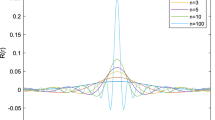Summary
We use the relativistic 2-body Dirac Hamiltonian with a square-well vector interaction, to investigate how the finite mass of the source of the external field changes the behavior of the bound-state spectrum from that of one Dirac particle in an attractive square well. Limiting ourselves for simplicity to states of total spin zero, we find that, as long as the massm 2 of the heavier particle is smaller than some critical massm c, the total energyE of the system does not reach the particle-antiparticle continuum, so that no difficulty of interpretation arises. If, however,m 2 is greater thanm c, there exists, as in the one-body Dirac equation, one value of the coupling strengthV c for whichE reaches the antiparticle continuum. Then, when the coupling strength exceedsV c, the bound-state level disappears. Furthermore, for some coupling strengthV>V c, there is a 2-particle bound-state level emerging from the particle-antiparticle continuum, whose total energyE increases until it reaches the particle-particle continuum. This latter result shows that, form 2>m c, a 2-body analysis actually further complicates the interpretation of deep bound states in relativistic quantum mechanics.
Riassunto
Si usa un'hamiltoniana di Dirac di due corpi relativistica con un'interazione vettoriale a pozzo quadrato, per scoprire come la massa finita della sorgente del campo esterno cambi il comportamento dello spettro dello stato legato da quello di una particella di Dirac in un pozzo quadrato attrattivo. Limitandoci per semplicità a stati con spin totale nullo, si trova che, finché la massam 2 della particella più pesante è più piccola di una certa massa criticam c, l'energia totale del sistemaE non raggiunge il continuo di particella-antiparticella, cosicché non insorge alcuna difficoltà di interpretazione. Ma, sem 2 è più grande dim c, esiste, come nell'equazione di Dirac a un corpo, la forza di accoppiamentoV c per la qualeE raggiunge il continuo di antiparticella. Poi, quando la forza di accoppiamento superaV c, il livello dello stato legato sparisce. Inoltre, per una certa forzaV>V c, c'è un livello dello stato legato a 2 particelle che emerge dal continuo di particella-antiparticella, la cui energia totaleE aumenta fino a raggiungere il continuo di particella-particella. Questo ultimo risultato mostra che, perm 2>m c, un'analisi a 2 corpi in realtà complica ulteriormente l'interpretazione degli stati iegati profondi nella meccanica quantistica relativistica.
Резюме
Мы используем релятивистский двухчастичный дираковский Гамильтониан с векторным взаимодействием в виде прямоугольной ямы, чтобы исследовать, как внешнее поле с источником конечной массы изменяет поведение спектра связанных состояний по сравнению со случаем одной дираковской частицы в прямоугольной яме притяжения. Ограничиваясь для простоты состояниями с полным спином, равным нулю, мы находим, что пока массаm 2 более тяжелой частицы меньше, чем критическая массаm c, то полная энергияE системы не достигает континуума «частиц-античастиц», так что не возникает никаких трудностей при интерпретации. Однако, еслиm 2 большеm c, то, как и в случае одночастичного уравнения Дирака, существует значение величины связиV c, для которогоE достигает континуума античастиц. Следовательно, когда величина связи превышаетV c, уровень связанного состояния исчезает. Кроме того для некоторой величины связиV>V c, существует уровень двухчастичного связанного состояния, появляющийся из континуума «частиц-античастиц», причем, полная энергияE увеличивается до тех пор, пока не достигнет континуума «частиц-античастиц». Последний результат показывает, что дляm 2>m c двухчастичный анализ существенно усложняет интерпретацию глубоких связанных состояний в релятивистской квантовой механике.
Similar content being viewed by others
References
L. I. Schiff, H. Snyder andJ. Weinberg:Phys. Rev.,57, 315 (1940).
B. Müller, J. Rafelski andW. Greiner:Zeits. Phys.,257, 62 (1972);Nuovo Cimento,18 A, 551 (1973);Ya. B. Zel'dovich andV. S. Popov:Usp. Fiz. Nauk,105, 403 (1971) (English translation:Sov. Phys. Usp.,14, 673 (1972)).
For a review of the Bethe-Salpeter equation, seeN. Nakanishi:Prog. Theor. Phys. Suppl.,43, 1 (1969). More recent work in connection with deep bound states is described inL. G. Suttorp:Nuovo Cimento,29 A, 225 (1975).
C. Fronsdal andR. W. Huff:Phys. Rev. D,3, 933 (1971);W. Dittrich:Phys. Rev. D,1, 3345 (1970).
For a derivation of the two-body Dirac equation from field theory see,e.g.,W. Królikowski andJ. Rzewuski:Nuovo Cimento,2, 203 (1955). There exists a wide range of alternative approaches to the relativistic two-body problem. Several may be traced through ref. (3,4)N. Nakanishi:Prog. Theor. Phys. Suppl.,43, 1 (1969). More recent work in connection with deep bound states is described inL. G. Suttorp:Nuovo Cimento,29 A, 225 (1975).C. Fronsdal andR. W. Huff:Phys. Rev. D,3, 933 (1971);W. Dittrich:Phys. Rev. D,1, 3345 (1970), the following references and the articles they cite:H. A. Bethe andE. E. Salpeter:Quantum Mechanics of One- and Two-Electron Atoms, Chap. II (Berlin and New York, N.Y., 1957);M. J. Moravcsik andH. P. Noyes:Ann. Rev. Nucl. Sci.,11, 95 (1961);A. Klein andT.-S. H. Lee:Phys. Rev. C,12, 1381 (1975);H. Enatsu andS. Kawaguchi:Nuovo Cimento,27 A, 458 (1975). For a discussion of quasi-potential equations in connection with the relativistic two-body problem, seeI. T. Todorov:Quasi-potential approach to the two-body problem in quantum field theory, inProperties of the Fundamental Interactions, Vol.9, Part C, edited byA. Zichichi (Bologna, 1973), p. 952.
H. M. Moseley andN. Rosen:Phys. Rev.,80, 177 (1950).
P. Horwitz:Phys. Rev.,161, 1415 (1967).
M. Nagasaki:Prog. Theor. Phys.,37, 437 (1967);39, 848 (1968).
Y. Koide:Prog. Theor. Phys.,39, 817 (1968).
K. Schilcher andH. J. W. Müller:Nuovo Cimento,4 A, 243 (1971).
E. Fermi andC. N. Yang:Phys. Rev.,76, 1739 (1949).
A. I. Akhiezer andV. B. Berestetskii:Quantum Electrodynamics (New York, N. Y., 1965), p. 119.
Author information
Authors and Affiliations
Additional information
Work supported in part by the U.S. Energy Research and Development Administration. Address from September 1976: The Research Laboratories, Building 81, Eastman Kodak Company, Rochester, N. Y. 14650.
Traduzione a cura della Redazione
Переведено редакцией.
Rights and permissions
About this article
Cite this article
Bawin, M., Lavine, J.P. Critical mass in a relativistic two-body problem. Nuovo Cim B 37, 45–54 (1977). https://doi.org/10.1007/BF02727956
Received:
Published:
Issue Date:
DOI: https://doi.org/10.1007/BF02727956



